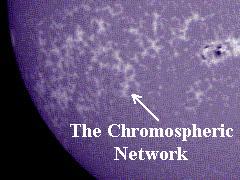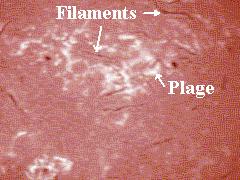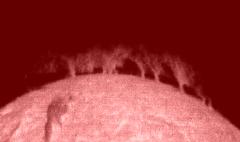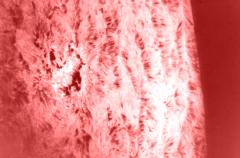 |
Click on image for larger version. |
|
The chromospheric network is a web-like pattern most easily seen in the
emissions of the red line of hydrogen (H-alpha) and the ultraviolet line of calcium (Ca II
K - from calcium atoms with one electron removed). The network outlines the supergranule cells and is due to the presence of
bundles of magnetic field lines that are concentrated there by the fluid motions in the
supergranules.
|
 |
Click on image for larger version. |
|
Filaments are dark, thread-like features seen in the red light of hydrogen
(H-alpha). These are dense, somewhat cooler, clouds of material that are suspended above
the solar surface by loops of magnetic field. Plage, the French word for beach, are bright
patches surrounding sunspots that are best seen in H-alpha. Plage are also associated with
concentrations of magnetic fields and form a part of the network of bright emissions that
characterize the chromosphere.
|
 |
Click on image for larger version. |
|
Prominences are dense clouds of material suspended above the surface of
the Sun by loops of magnetic field. Prominences and filaments are actually the same things
except that prominences are seen projecting out above the limb, or edge, of the Sun. Both
filaments and prominences can remain in a quiet or quiescent state for days or weeks.
However, as the magnetic loops that support them slowly change, filaments and prominences
can erupt and rise off of the Sun over the course of a few minutes or hours
(4.0 MB MPEG movie of the "Granddaddy"
prominence eruption of 1946 June 4).
|
 |
Click on image for larger version. |
|
Spicules are small, jet-like eruptions seen throughout the chromospheric
network. They appear as short dark streaks in the H-alpha image to the left (National Solar Observatory/Sacramento Peak).
They last but a few minutes but in the process eject material off of the surface and
outward into the hot corona at speeds of 20 to 30 km/s.
|





